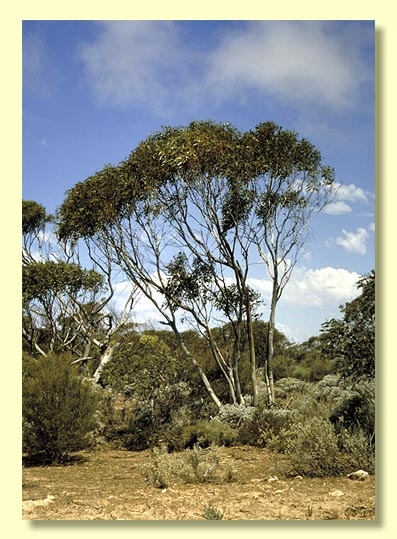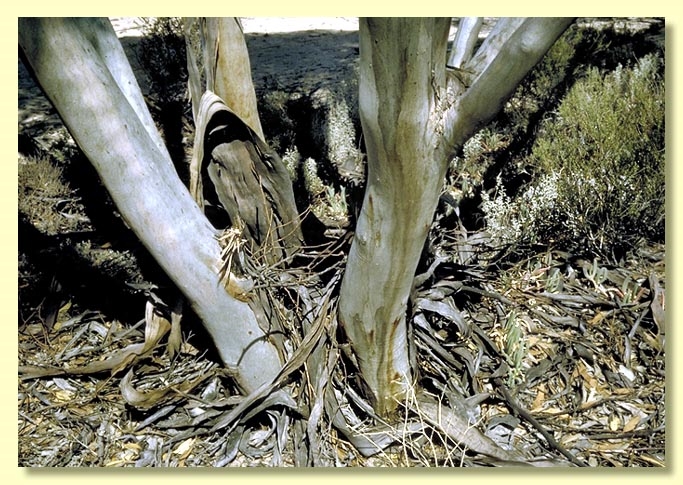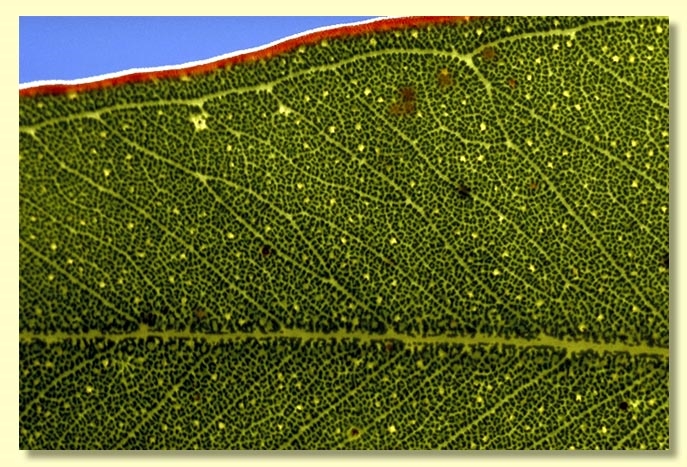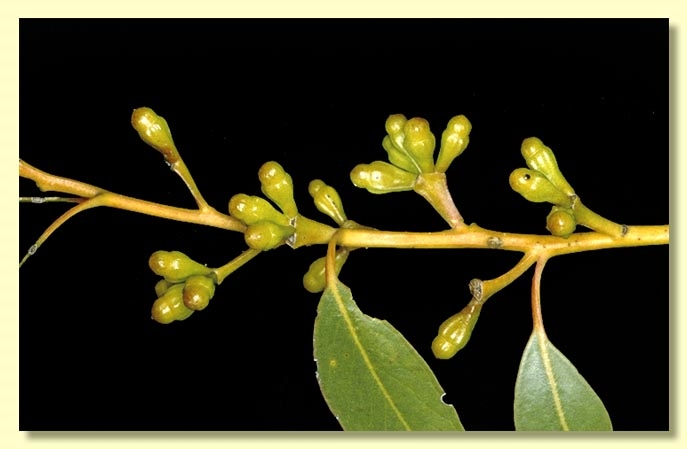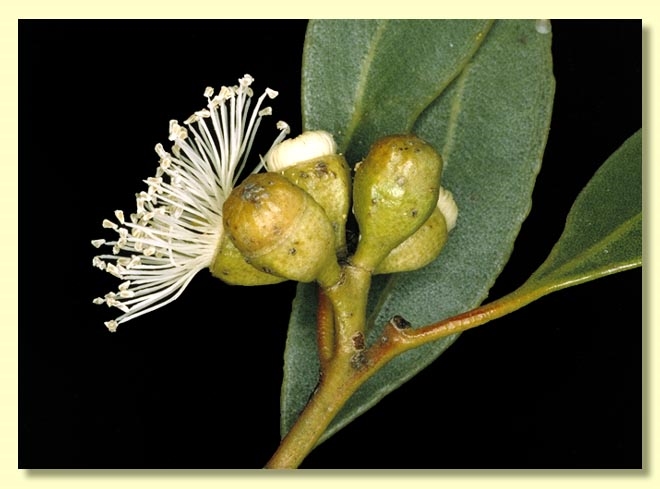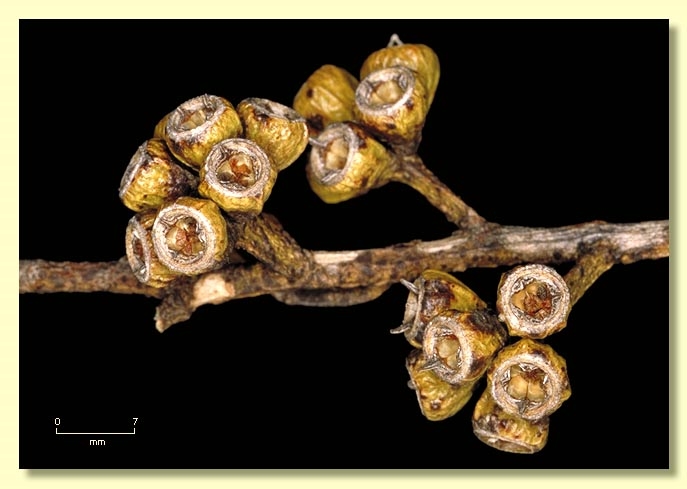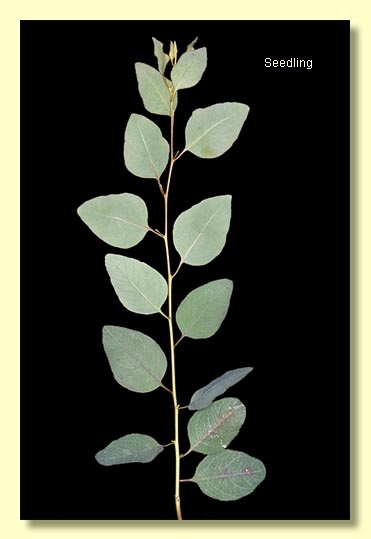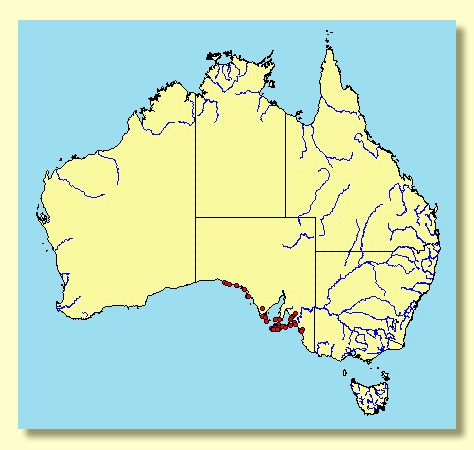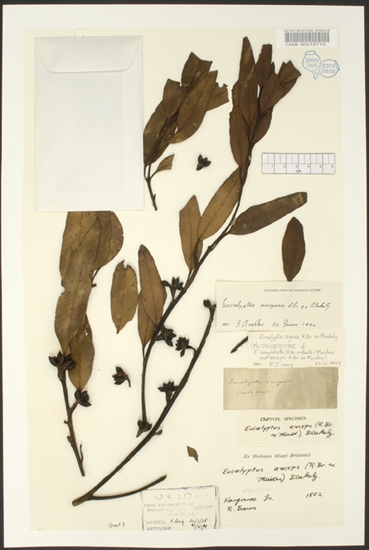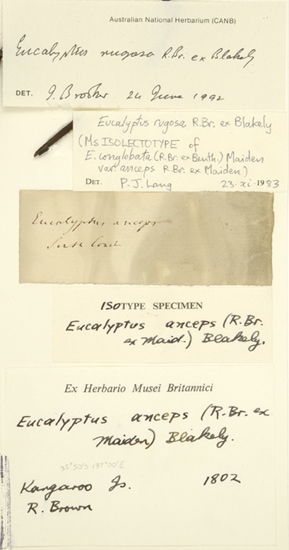Euclid - Online edition
Eucalyptus rugosa
Eucalyptus | Symphyomyrtus | Dumaria | Corrugatae
T: Fowler's Bay, [S.A.], Jan. 1802, R.Brown s.n.; holo: K; iso: CANB.
Eucalyptus anceps (R.Br. ex Maiden) Blakely, Key Eucalypts: 118 (1934). E. conglobata ?var. anceps R.Br. ex Maiden, Crit. Revis. Eucalyptus 6: 275 (1924). Type: Kangaroo Island [South Australia], Mar. 1802, R. Brown; holo: BM; iso: CANB, E, K, MEL, NSW, fide J.H. Maiden, Crit. Revis. Eucalyptus 1: 101 (1904).
Bark smooth throughout, cream to pale grey, pinkish grey or yellow-green, sometimes with ribbons of decorticated bark in the upper branches.
Branchlets have oil glands in the pith.
Juvenile growth (coppice or field seedlings to 50 cm): stems rounded or square in cross-section; juvenile leaves always petiolate, opposite to node 5 then alternate, ovate to lanceolate, 5–8.5 cm long, 2–4 cm wide, dull, green to grey-green.
Adult leaves alternate, petiole 0.6–2.7 cm long; blade lanceolate or broadly lanceolate, 5–12 cm long, 0.7–3 cm wide, base tapering to petiole or sometimes oblique, concolorous, glossy, green, side-veins at an acute or wider angle to midrib, densely to very densely reticulate, intramarginal vein parallel to and well removed from margin, oil glands mostly intersectional.
Inflorescence axillary unbranched, peduncles 0.6–2 cm long, buds 7, 9 or 11, sessile or pedicellate, pedicels 0–0.5 cm long. Mature buds obovoid to ovoid or cylindrical (0.8–1.2 cm long, 0.5–0.8 cm wide), green or red-brown, with longitudinal ribs, scar present, operculum rounded to flattened (0.3–0.6 cm long), usually narrower than the hypanthium at the join, stamens inflexed, anthers cuboid to cuneate, versatile, dorsifixed, dehiscing by longitudinal slits (non-confluent), style long, stigma tapered or blunt, locules 3 or 4, the placentae each with 4 vertical ovule rows. Flowers white.
Fruit sessile or pedicellate, pedicels 0–0.4 cm long, cup-shaped, obconical or hemispherical, 0.6–1.1 cm long, 0.6–1 cm wide, usually ribbed longitudinally, disc level or descending, valves 3 or 4, near rim level or exserted.
Seeds grey to grey-brown, 1.8–2.5 mm long, ovoid or depressed-ovoid, often pointed at one end, dorsal surface pitted, hilum ventral.
Cultivated seedlings (measured at ca node 10): cotyledons reniform; stems rounded to square in cross-section; leaves always petiolate, opposite for 3 to 5 nodes then alternate, ovate, 4–7 cm long, 1.8–4 cm wide, dull, green or slightly grey-green.
Flowering has been recorded in January, February, March, September and December.
A mallee endemic to South Australia, of disjunct coastal and subcoastal distribution on southern Eyre Peninsula, Yorke Peninsula, Kangaroo Island and the Coorong area. The stems are smooth and the adult leaves glossy green.
Eucalyptus rugosa belongs in Eucalyptus subgenus Symphyomyrtus section Dumaria because the buds have two opercula, stamens are strongly inflexed, ovules are in four rows on the placentae and cotyledons are reniform. Within this larger grouping E. rugosa and six other species—E. melanoxylon, E. concinna, E. corrugata, E. griffithsii, E. brachycalyx and E. laevis—form a subgroup, series Corrugatae, all with ovoid, conspicuously pitted seeds and with dark brown oil glands in the pith of the branchlets.
E. rugosa is distinguished from its near relatives by the combination of mallee habit, smooth bark, axillary umbels of 7–11 small, striate, blunt buds and small fruit. Its geographically closest relative is E. brachycalyx, which has a more inland distribution, some rough bark and buds that have less blunt to conical opercula.
This species, like E. brachycalyx, may at times be confused with E. oleosa. However, E. oleosa lacks pith glands in the branchlets, has smooth seed, and its dehisced fruit have erect, not spreading, valves.
Eucalyptus anceps is regarded as a synonym of E. rugosa. Smooth-barked mallees regarded elsewhere (e.g. Chippendale 1988) as E. anceps are now E. phenax subsp. phenax. The type specimen of E. anceps is a specimen of E. rugosa. See Brooker & Slee (1996) for details.

